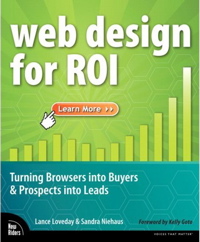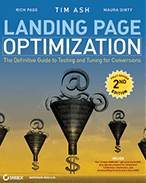Book Review: Web Design for ROI
Last updated | Its tough to get an education on web analytics – not like you can just go and get a bachelors in it very easily. Other than keeping up with the best web analytics blogs, I get a lot of my education from reading web analytics related books – I am always reading the latest.
Its tough to get an education on web analytics – not like you can just go and get a bachelors in it very easily. Other than keeping up with the best web analytics blogs, I get a lot of my education from reading web analytics related books – I am always reading the latest.
Recently, I read one whose title sparked my interest: ‘Web Design for ROI‘ by Lance Loveday and Sandra Niehaus. And why? Because one of my biggest pet peeves is visiting a website that obviously was built by web developers and marketers, who think they know best, without any idea how to optimize their website to make even greater profits. And this is what caused most of the websites like pets.com to go belly up in the late 90s dot com bust. They simply thought that building a website, and spending millions of dollars on cool advertising campaigns would be enough. Wrong! To succeed, they should have first built an optimized website which drives as much ROI as possible, and then begin spending money on a cool marketing campaign to generate traffic. Thats what this book is all about. Its packed with tips to help improve the ROI of your website – ‘turning browsers into buyers, and prospects into leads’, as the book tag line promises. Read on for my review…
Why you should get this book: Plain and simple, it will make your website greater profits! One of the main areas this book focuses on is how to increase site conversion, thus increasing ROI. They draw some great analogies that really drive home the fact that spending more money on increasing conversion brings a much higher ROI than simply increasing advertising spend. First increase your conversion rate, and then spend money on the advertising – you get the best of both worlds then.
I also liked the way this book gets you to think of your website through the eyes of your visitor, and to come up with answers to key questions that a visitor might ask themselves (like ‘does this website look creditable and trustworthy’). Excellent way of thinking, which not just improves ROI, but improves the visitors website experience – which really should be the most important goal of any website. One surprising point they seemed to dismiss was the value of surveying – they claim to think that only negativer users will take surveys, thus skewing results. Interesting, but I don’t necessarily agree.
The section on designing website landing pages for better ROI is also very insightful, and includes many different things to ponder with relevant images, from simplification, to segmenting and personalizing for visitors needs. In particular, I liked their idea of adding a secondary ‘safety valve’ call to action to a landing page, just in case a visitor doesn’t understand or want to follow your primary call to action. They also pay good attention to the importance of improving ‘category’ pages too – something that many web marketers and designers fail to realize the importance of. The rest of the book is rounded out by offering great advice and tips for improving forms and shopping carts on your website – vital ingredients for helping improve website ROI.
Who should read this book: I find this book to be a great compliment to any web analyst or marketeers work – its really valuable to know all these best practices in the back of your mind, and provide a great backbone for testing ideas (even though they don’t really emphasize much on testing).
This book is perfect for ‘web people’ to gain a new understanding of these web design ROI fundamentals, but for more advanced web analysts like myself, I found many of the ideas a little too simplistic and could have used a little more meat to them (maybe it could have been longer too). But overall, this is an excellent informative web analytics related book, and I strongly recommend you not only read this book, but make sure your boss and colleagues read it too, so they get on the same ROI-improving wavelength as you. They will be thanking you!



